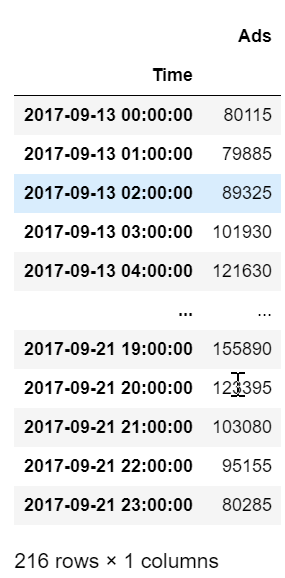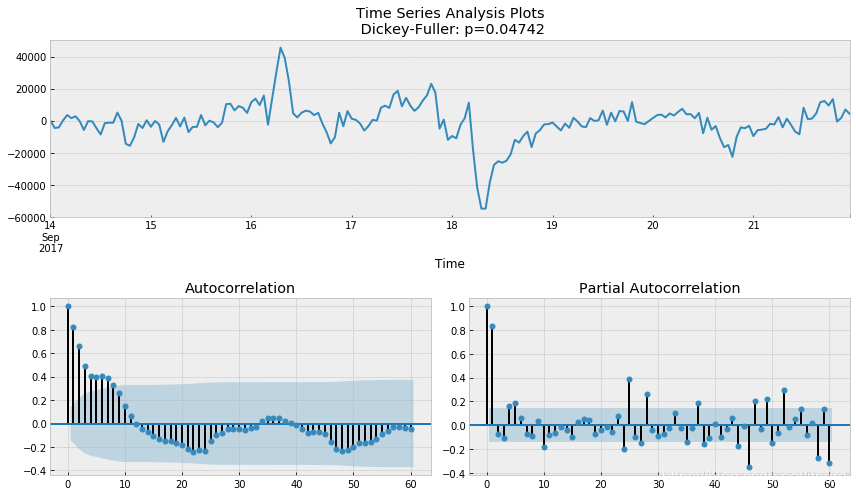SARIMA(p,d,q)(P,D,Q,s) 季节性自回归移动平均模型,结构参数有七个
AR(p) 自回归模型,即用自己回归自己。
基本假设是,当前序列值取决于其带有时滞的先前值。模型中的最大滞后记为 p
要确定初始 p,需要查看PACF图并找到最大的显着滞后,之后其他大多数滞后变得无关紧要。
MA(q) 移动平均模型,是对时间序列的误差进行建模,并假设当前误差取决于带有滞后的误差。可以在ACF图上找到初始值。
结合以上两种方法:,就是自回归移动平均模型
剩下的参数:
I(d)
- order of integration. This is simply the number of nonseasonal differences needed to make the series stationary. In our case, it’s just 1 because we used first differences.
Adding this letter to the four gives us the ARIMA
model which can handle non-stationary data with the help of nonseasonal differences. Great, one more letter to go!
S(s)
- this is responsible for seasonality and equals the season period length of the series
With this, we have three parameters: (P,D,Q)
P
- order of autoregression for the seasonal component of the model, which can be derived from PACF. But you need to look at the number of significant lags, which are the multiples of the season period length. For example, if the period equals 24 and we see the 24-th and 48-th lags are significant in the PACF, that means the initial P
should be 2.
Q
- similar logic using the ACF plot instead.
D
- order of seasonal integration. This can be equal to 1 or 0, depending on whether seasonal differeces were applied or not.
好了,接下来我们用 SARIMA 来建模 😏
导入包
import warnings # do not disturbe mode
warnings.filterwarnings('ignore')
# Load packages
import numpy as np # vectors and matrices
import pandas as pd # tables and data manipulations
import matplotlib.pyplot as plt # plots
import seaborn as sns # more plots
from dateutil.relativedelta import relativedelta # working with dates with style
from scipy.optimize import minimize # for function minimization
import statsmodels.formula.api as smf # statistics and econometrics
import statsmodels.tsa.api as smt
import statsmodels.api as sm
import scipy.stats as scs
from itertools import product # some useful functions
from tqdm import tqdm_notebook
# Importing everything from forecasting quality metrics
from sklearn.metrics import r2_score, median_absolute_error, mean_absolute_error
from sklearn.metrics import median_absolute_error, mean_squared_error, mean_squared_log_error
# MAPE
def mean_absolute_percentage_error(y_true, y_pred):
return np.mean(np.abs((y_true - y_pred) / y_true)) * 100
def tsplot(y, lags=None, figsize=(12, 7), style='bmh'):
"""
Plot time series, its ACF and PACF, calculate Dickey–Fuller test
y - timeseries
lags - how many lags to include in ACF, PACF calculation
"""
if not isinstance(y, pd.Series):
y = pd.Series(y)
with plt.style.context(style):
fig = plt.figure(figsize=figsize)
layout = (2, 2)
ts_ax = plt.subplot2grid(layout, (0, 0), colspan=2)
acf_ax = plt.subplot2grid(layout, (1, 0))
pacf_ax = plt.subplot2grid(layout, (1, 1))
y.plot(ax=ts_ax)
p_value = sm.tsa.stattools.adfuller(y)[1]
ts_ax.set_title('Time Series Analysis Plots\n Dickey-Fuller: p={0:.5f}'.format(p_value))
smt.graphics.plot_acf(y, lags=lags, ax=acf_ax)
smt.graphics.plot_pacf(y, lags=lags, ax=pacf_ax)
plt.tight_layout()
读取数据
ads = pd.read_csv('ads.csv', index_col=['Time'], parse_dates=['Time'])

plt.figure(figsize=(18, 6))
plt.plot(ads.Ads)
plt.title('Ads watched (hourly data)')
plt.grid(True)
plt.show()

tsplot(ads.Ads, lags=60)

# The seasonal difference
ads_diff = ads.Ads - ads.Ads.shift(24)
tsplot(ads_diff[24:], lags=60)

ads_diff = ads_diff - ads_diff.shift(1)
tsplot(ads_diff[24+1:], lags=60)

SARIMA参数
- p 是 4,因为PACF上 的最后一个显著滞后,此后,其他大多数都不显著。
- d 是1,因为做了一阶差分
- q 根据 ACF 应该是 4 左右
- P 可能是2,因为 24 和 48 的滞后在PACF上有些重要
- D 是 1,因为我们做了季节差分
- Q 可能为1,ACF的第24个滞后很明显,而第48个的滞后则不是
# setting initial values and some bounds for them
ps = range(2, 5)
d=1
qs = range(2, 5)
Ps = range(0, 2)
D=1
Qs = range(0, 2)
s = 24 # season length is still 24
# creating list with all the possible combinations of parameters
parameters = product(ps, qs, Ps, Qs)
parameters_list = list(parameters)
len(parameters_list) # 36
根据 AIC 调参
def optimizeSARIMA(parameters_list, d, D, s):
"""Return dataframe with parameters and corresponding AIC
parameters_list - list with (p, q, P, Q) tuples
d - integration order in ARIMA model
D - seasonal integration order
s - length of season
"""
results = []
best_aic = float("inf")
for param in tqdm_notebook(parameters_list):
# we need try-except because on some combinations model fails to converge
try:
model=sm.tsa.statespace.SARIMAX(ads.Ads, order=(param[0], d, param[1]),
seasonal_order=(param[2], D, param[3], s)).fit(disp=-1)
except:
continue
aic = model.aic
# saving best model, AIC and parameters
if aic < best_aic:
best_model = model
best_aic = aic
best_param = param
results.append([param, model.aic])
result_table = pd.DataFrame(results)
result_table.columns = ['parameters', 'aic']
# sorting in ascending order, the lower AIC is - the better
result_table = result_table.sort_values(by='aic', ascending=True).reset_index(drop=True)
return result_table
warnings.filterwarnings("ignore")
result_table = optimizeSARIMA(parameters_list, d, D, s)
'''
parameters aic
0 (2, 3, 1, 1) 3888.642174
1 (3, 2, 1, 1) 3888.763568
2 (4, 2, 1, 1) 3890.279740
3 (3, 3, 1, 1) 3890.513196
4 (2, 4, 1, 1) 3892.302849
5 (4, 3, 1, 1) 3892.322855
6 (3, 4, 1, 1) 3893.762846
7 (4, 4, 1, 1) 3894.327967
8 (2, 2, 1, 1) 3894.798147
9 (2, 3, 0, 1) 3897.170902
10 (3, 2, 0, 1) 3897.815032
11 (4, 2, 0, 1) 3899.073591
12 (3, 3, 0, 1) 3899.165271
13 (3, 4, 0, 1) 3900.500309
14 (2, 4, 0, 1) 3900.502494
15 (4, 3, 0, 1) 3901.255700
16 (4, 4, 0, 1) 3902.650501
17 (2, 2, 0, 1) 3903.905714
18 (2, 3, 1, 0) 3909.281188
19 (3, 2, 1, 0) 3909.502838
20 (4, 2, 1, 0) 3910.927759
21 (3, 3, 1, 0) 3911.192654
22 (3, 4, 1, 0) 3911.344351
23 (2, 4, 1, 0) 3911.809710
24 (4, 4, 1, 0) 3913.084053
25 (4, 3, 1, 0) 3913.409057
26 (2, 2, 1, 0) 3914.786853
27 (3, 2, 0, 0) 3925.433806
28 (2, 2, 0, 0) 3925.786566
29 (2, 3, 0, 0) 3925.879649
30 (2, 4, 0, 0) 3926.311190
31 (3, 3, 0, 0) 3927.427240
32 (4, 2, 0, 0) 3927.427417
33 (3, 4, 0, 0) 3928.376406
34 (4, 3, 0, 0) 3929.059361
35 (4, 4, 0, 0) 3930.078725
'''
# set the parameters that give the lowest AIC
p, q, P, Q = result_table.parameters[0]
best_model=sm.tsa.statespace.SARIMAX(ads.Ads, order=(p, d, q),
seasonal_order=(P, D, Q, s)).fit(disp=-1)
print(best_model.summary())
'''
Statespace Model Results
==========================================================================================
Dep. Variable: Ads No. Observations: 216
Model: SARIMAX(2, 1, 3)x(1, 1, 1, 24) Log Likelihood -1936.321
Date: Sat, 07 Mar 2020 AIC 3888.642
Time: 15:00:14 BIC 3914.660
Sample: 09-13-2017 HQIC 3899.181
- 09-21-2017
Covariance Type: opg
==============================================================================
coef std err z P>|z| [0.025 0.975]
------------------------------------------------------------------------------
ar.L1 0.7913 0.270 2.928 0.003 0.262 1.321
ar.L2 -0.5503 0.306 -1.799 0.072 -1.150 0.049
ma.L1 -0.7316 0.262 -2.793 0.005 -1.245 -0.218
ma.L2 0.5651 0.282 2.005 0.045 0.013 1.118
ma.L3 -0.1811 0.092 -1.964 0.049 -0.362 -0.000
ar.S.L24 0.3312 0.076 4.351 0.000 0.182 0.480
ma.S.L24 -0.7635 0.104 -7.361 0.000 -0.967 -0.560
sigma2 4.574e+07 5.61e-09 8.15e+15 0.000 4.57e+07 4.57e+07
===================================================================================
Ljung-Box (Q): 43.70 Jarque-Bera (JB): 10.56
Prob(Q): 0.32 Prob(JB): 0.01
Heteroskedasticity (H): 0.65 Skew: -0.28
Prob(H) (two-sided): 0.09 Kurtosis: 4.00
===================================================================================
Warnings:
[1] Covariance matrix calculated using the outer product of gradients (complex-step).
[2] Covariance matrix is singular or near-singular, with condition number 1.08e+32. Standard errors may be unstable.
'''
tsplot(best_model.resid[24+1:], lags=60)

def plotSARIMA(series, model, n_steps):
"""Plots model vs predicted values
series - dataset with timeseries
model - fitted SARIMA model
n_steps - number of steps to predict in the future
"""
# adding model values
data = series.copy()
data.columns = ['actual']
data['sarima_model'] = model.fittedvalues
# making a shift on s+d steps, because these values were unobserved by the model
# due to the differentiating
data['sarima_model'][:s+d] = np.NaN
# forecasting on n_steps forward
forecast = model.predict(start = data.shape[0], end = data.shape[0]+n_steps)
forecast = data.sarima_model.append(forecast)
# calculate error, again having shifted on s+d steps from the beginning
error = mean_absolute_percentage_error(data['actual'][s+d:], data['sarima_model'][s+d:])
plt.figure(figsize=(15, 7))
plt.title("Mean Absolute Percentage Error: {0:.2f}%".format(error))
plt.plot(forecast, color='r', label="model")
plt.axvspan(data.index[-1], forecast.index[-1], alpha=0.5, color='lightgrey')
plt.plot(data.actual, label="actual")
plt.legend()
plt.grid(True)
plotSARIMA(ads, best_model, 50)

来源:CSDN
作者:颹蕭蕭
链接:https://blog.csdn.net/itnerd/article/details/104715508